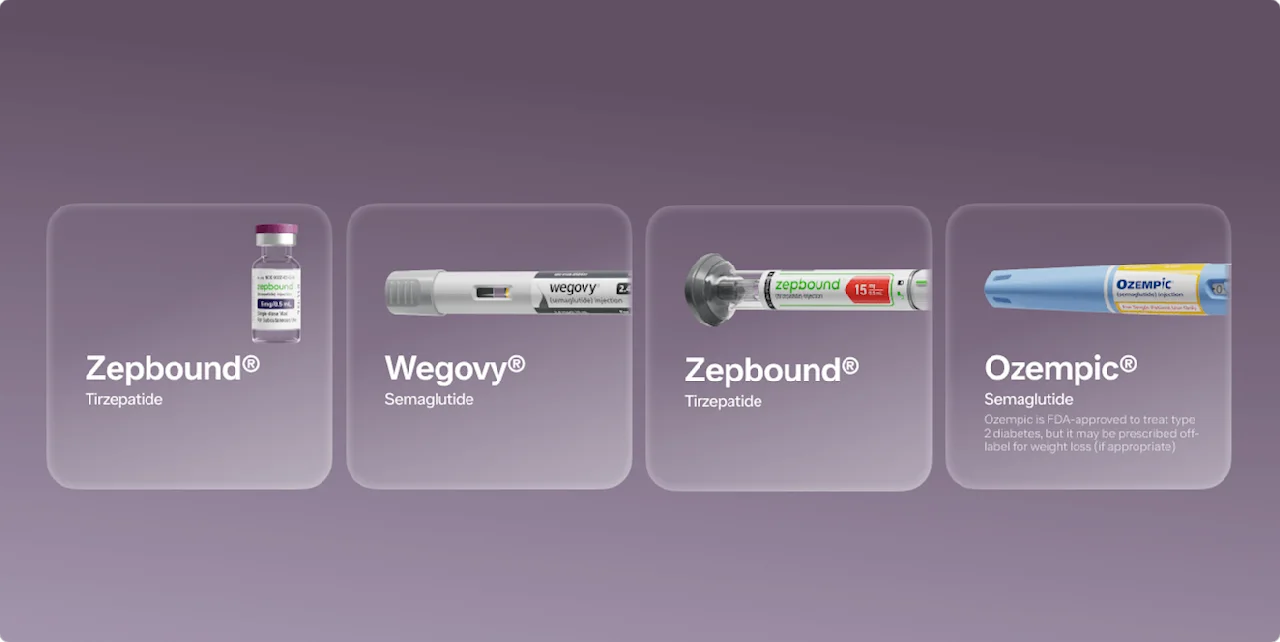Here's what we'll cover
Here's what we'll cover
If you've been diagnosed with type 2 diabetes or prediabetes, you might be feeling confused or uncertain about what you should be doing to manage your condition. But there is some good news. By making some simple lifestyle changes, like adopting a diabetes diet, you can take control of your blood glucose levels— possibly even to the point where you no longer need medications.
Getting your blood sugar under control can help you avoid diabetes' more serious effects, including cardiovascular disease, erectile dysfunction, issues with vision, and even circulation problems that can lead to amputation.
What is diabetes?
People with diabetes, especially poorly controlled diabetes, are at higher risk for developing serious medical conditions like heart disease, strokes, circulation problems, poor vision, kidney problems, and more. For these reasons, it is important to get your diabetes under control—your healthcare provider can help with that.
Diabetes is typically diagnosed by checking your fasting blood sugar levels, which are checked after eight hours of no food or drink. If these levels are consistently above 126 mg/dL, you may have diabetes.
Another test checks your hemoglobin A1c (HbA1c) levels. HbA1c is a protein that forms when your red blood cells come into contact with sugars in the blood—the more sugar floating around, the higher your HbA1c. If it measures greater than 6.5%, you may be diagnosed with diabetes (Sapra, 2021).
Types of diabetes
There are two main types of diabetes: type 1 and type 2.
In type 1 diabetes, the pancreas loses the cells that make insulin, usually from an autoimmune process. Insulin is a necessary hormone your body uses to break down glucose (sugar) from food for energy, allowing your blood sugar levels to stay within a healthy range.
Because they can’t make their own insulin, people with type 1 diabetes must manage their condition with insulin injections before eating. This type of diabetes usually starts in childhood or young adulthood, though it can start in adulthood in some cases (Sapra, 2021).
Type 2 diabetes is much more common and is the form most people talk about when they say “diabetes.” In this form, the pancreas produces insulin—at least initially—but the cells have become resistant. Insulin resistance is usually a gradual process that occurs over many years.
Insulin resistance often happens in response to diet and lifestyle choices and is strongly associated with excess body fat and a sedentary lifestyle. Diabetes management for people with type 2 diabetes often involves prescribed medications to help keep blood sugars in check. If your diabetes remains uncontrolled with pills, you may need insulin injections (Sapra, 2021).
There is a third type of diabetes called gestational diabetes, which only occurs in pregnant women. It affects approximately 2–10% of pregnancies in the U.S., and people with gestational diabetes have an increased risk of developing diabetes later in life. For most people, gestational diabetes management involves eating a balanced diet, exercising, and checking blood glucose levels frequently (Quintanilla, 2021).
What is prediabetes?
Prediabetes is the body's equivalent of a flashing red light at a railroad crossing—something you want to dodge is coming down the track. Prediabetes is when your blood sugar level is elevated but not quite high enough to be type 2 diabetes.
Over 90% of people with prediabetes don’t usually have any of the signs or symptoms of diabetes—most don’t realize they are even living with this condition. More than 1 in 3 adults in the U.S. have prediabetes. Up to 70% of those people will progress to having diabetes. Pay attention to this warning sign, and you may be able to reverse the condition by better managing your glucose levels with lifestyle modifications (Alvarez, 2021).
There is no way to cure diabetes. However, it may be possible to control your diabetes well enough with lifestyle modifications that you no longer need to use medications to manage your diabetes. This is often referred to as pushing your diabetes into remission.
One of the best ways to encourage diabetes remission is to incorporate lifestyle changes into your routine, like improving your diet and keeping your weight in a healthy range. Obesity is one of the highest risk factors for type 2 diabetes—but you have the power to change it. Even losing just 7% of your total body weight may be enough to prevent the transition from prediabetes to type 2 diabetes. For someone who weighs 250 pounds, that means losing just 17.5 pounds—an achievable feat for most, without any extreme dieting or weight loss measures (Dagogo-Jack, 2020).
What is a diabetes diet?
People adopt a “diabetes diet” when they want to lower their blood sugars through dietary changes. According to the American Diabetes Association (ADA), there is no single diabetes diet. Rather, several eating patterns encourage you to decrease carbohydrates (or carbs), simple sugars, and overall fat in your diet. Controlling your portion sizes and lowering your caloric intake also helps. This diabetic meal plan also encourages eating high-fiber foods, which can help you eat less, stay fuller longer, and lose weight (Evert, 2019).
Foods to eat on a diabetes diet
While there are several eating patterns you can follow (carb counting, Mediterranean diet, etc.), the Diabetes Plate Method is one easy way to train yourself to eat healthier foods (ADA, n.d.):
Fill half your plate with non-starchy vegetables like spinach, carrots, and tomatoes.
Fill one-quarter of your plate with high-fiber foods like brown rice, whole wheat bread, legumes, and quinoa.
Fill one-quarter of your plate with lean meats or proteins like chicken breast, tuna, lean beef, seafood, and tofu.
Eat healthy fats like olive oil and avocado.
Foods to avoid on a diabetes diet
If you have high blood sugar, you should avoid foods that raise your blood glucose further, also known as foods with a high glycemic index. This includes foods like (Evert, 2019):
Simple sugars like candy, sweets, desserts, etc.
Sugary drinks like soft drinks, juices, etc.
Refined carbohydrates like white bread, white rice, pasta, etc.
Foods with added sugars or saturated fats like butter, hot dogs, sausage
Benefits of a diabetes diet
A balanced diet that encourages nutritious foods high in fiber and low in sugar and refined carbohydrates can help you lower your blood sugar levels. Lowering your blood sugar levels has health benefits like decreasing your risk of heart disease, strokes, kidney problems, and other medical issues.
As a bonus, some people following a diabetic eating pattern end up eating fewer calories and actually lose weight, which can help improve your overall health. Lastly, some studies suggest that following this eating pattern may help lower cholesterol levels, improve blood pressure, and decrease your risk of heart disease (Evert, 2019).
Risks of a diabetes diet
The main risk of following a diabetic diet is staying with the program. One of the best ways to incorporate these recommendations into your routine is to cook your meals at home. Restaurants, even the “healthy” ones, often add extra oil, salt, butter, etc., to make their food taste better and keep you coming back for more. But all those extra calories add up.
Some people find it more convenient to eat out or buy processed foods. While they can make life easier, they are not the most nutritious options and can make sticking to this eating style more challenging. Meal planning is one trick that some people use to make healthy food choices and diabetes eating plans easier to follow.
Is a diabetes diet recommended?
The overall eating pattern of a diabetes diet encourages healthy eating like whole grains, vegetables, lean proteins, and unsaturated fats. This eating pattern may help people trying to lose weight or improve their health, especially when combined with daily exercise.
As mentioned previously, there is no specific “diabetes diet,” but rather, lifestyle changes that encourage you to make healthy eating choices. Talk to your healthcare provider, dietitian, or diabetes educator for additional meal plan tips.
Tips to remember for a successful diabetes diet
Stay away from sugary beverages; drink water, coffee, or tea instead.
Eat more fruits and vegetables, especially non-starchy vegetables like spinach, kale, etc.
Check food labels for hidden sugars in packaged foods.
Get more fiber, like whole grains, to help you stay fuller longer.
Avoid saturated fats like butter and opt for healthy fats like avocado, olive oil, etc.
Add exercise to your daily routine.
DISCLAIMER
If you have any medical questions or concerns, please talk to your healthcare provider. The articles on Health Guide are underpinned by peer-reviewed research and information drawn from medical societies and governmental agencies. However, they are not a substitute for professional medical advice, diagnosis, or treatment.
Alvarez S, Coffey R, Algotar AM. (2021). Prediabetes. In: StatPearls [Internet]. Retrieved from https://www.ncbi.nlm.nih.gov/books/NBK459332/
American Diabetes Association (ADA). (n.d.). Recipes & nutrition. Retrieved on Aug 2, 2021 from https://www.diabetes.org/healthy-living/recipes-nutrition
Dagogo-Jack, S., Brewer, A. A., Owei, I., French, L., Umekwe, N., Rosenthal, R., et al. (2020). Pathobiology and reversibility of prediabetes in a biracial cohort (prop-abc) study: design of lifestyle intervention. BMJ Open Diabetes Research & Care, 8 (1), e000899. doi: 10.1136/bmjdrc-2019-000899. Retrieved from https://pubmed.ncbi.nlm.nih.gov/32527719
Evert, A. B., Dennison, M., Gardner, C. D., Garvey, W. T., Lau, K., MacLeod, J., et al. (2019). Nutrition therapy for adults with diabetes or prediabetes: A consensus report. Diabetes Care, 42 (5), 731–754. doi: 10.2337/dci19-0014. Retrieved from https://pubmed.ncbi.nlm.nih.gov/31000505/
Quintanilla Rodriguez BS, Mahdy H. (2021). Gestational diabetes. In: StatPearls [Internet]. Retrieved from https://www.ncbi.nlm.nih.gov/books/NBK545196/
Sapra A, Bhandari P. (2021). Diabetes mellitus. In: StatPearls [Internet]. Retrieved from https://www.ncbi.nlm.nih.gov/books/NBK551501/










